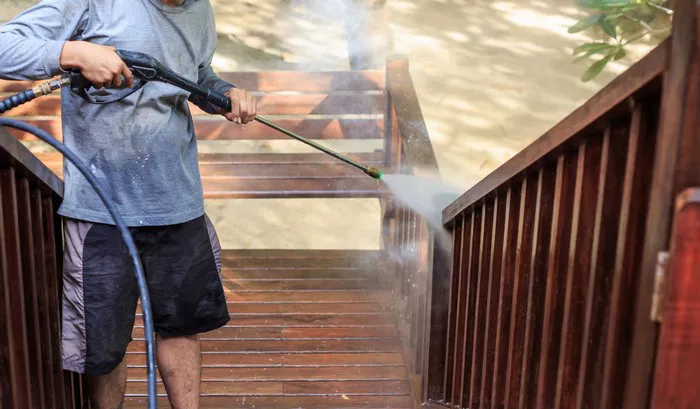Pressure washing, also known as power washing, is a cleaning method that utilizes high-pressure water to remove dirt, grime, mold, and mildew from various surfaces. From driveways to siding, pressure washing is a versatile solution for restoring the cleanliness and appearance of outdoor surfaces.
Benefits
The primary advantage of pressure washing is its effectiveness in deep cleaning surfaces that are difficult to clean using traditional methods. The high-pressure water stream generated by pressure washers can penetrate cracks and crevices, removing stubborn stains and buildup with ease. Additionally, pressure washing is a time-efficient solution, allowing users to complete cleaning tasks quickly and with minimal effort.
Equipment Overview
Pressure Washer Components
A typical pressure washer consists of several key components:
1. Pump: The pump pressurizes water from a garden hose to create a high-pressure stream.
2. Engine or Motor: Provides the power necessary to drive the pump.
3. Hose: Transports pressurized water from the pump to the spray wand.
4. Wand: The extension wand allows users to reach distant surfaces while controlling the direction of the water stream.
5. Nozzle: The nozzle determines the spray pattern and intensity of the water stream.
Types of Pressure Washers
Pressure washers come in various types, including:
1. Gas-Powered: Ideal for outdoor use and heavy-duty cleaning tasks.
2. Electric: Suitable for smaller cleaning jobs and indoor use where exhaust fumes are a concern.
3. Commercial-Grade: Designed for professional use, offering higher pressure and flow rates for demanding applications.
Preparing for Pressure Washing
Safety Precautions
Before starting a pressure washing job, it’s essential to prioritize safety:
1. Wear protective gear such as goggles, gloves, and closed-toe shoes to shield against debris and chemicals.
2. Avoid wearing loose clothing that could get caught in the equipment.
Surface Inspection
Inspect the surface to be cleaned for any damage or delicate areas that may require special care. Look for cracks, loose paint, or fragile surfaces that could be damaged by high-pressure water.
Selecting the Right Nozzle and Pressure
Nozzle Types
Different nozzle types produce varying spray patterns and pressure levels:
1. 0-degree: Provides a narrow, concentrated stream suitable for tough stains and precise cleaning.
2. 15-degree: Offers a slightly wider stream for general-purpose cleaning tasks.
3. 25-degree: Provides a wider spray pattern for larger surface areas.
4. 40-degree: Delivers a broad, gentle stream ideal for rinsing and delicate surfaces.
5. Detergent Nozzle: Designed for applying detergent using the pressure washer’s detergent injection system.
Pressure Adjustment
Adjust the pressure settings on the pressure washer according to the surface being cleaned. Higher pressure may be necessary for tough stains, while lower pressure is suitable for delicate surfaces to avoid damage.
Applying Detergent (if applicable)
Detergent Selection
Choose a detergent suitable for the surface being cleaned, such as concrete cleaner, wood cleaner, or vinyl siding cleaner. Use environmentally friendly detergents whenever possible to minimize impact on the surrounding environment.
Application Method
Apply detergent using the pressure washer’s detergent injection system or a separate applicator. Follow the manufacturer’s instructions for mixing the detergent with water and adjust the application rate accordingly.
Pressure Washing Technique
Starting Point
Begin pressure washing from the top of the surface and work downward to ensure thorough cleaning and prevent streaking. This technique allows dirt and debris to be washed away effectively without recontaminating cleaned areas.
Overlap Technique
Overlap each pass by about 50% to ensure complete coverage and avoid missing spots. This technique helps to achieve consistent cleaning results and prevent streaking or uneven cleaning patterns.
Rinse and Final Inspection
Rinsing
After pressure washing, thoroughly rinse the cleaned surface with clean water to remove any detergent residue and debris. Use a broad spray pattern and maintain a safe distance to prevent damage to the surface.
Final Inspection
Inspect the cleaned surface for any missed spots or areas that may require additional attention. Touch up any remaining stains or buildup using appropriate cleaning techniques or spot treatments.
Post-Cleaning Maintenance
Equipment Care
Properly clean and maintain the pressure washer after each use to ensure optimal performance and longevity. This includes flushing the system with clean water, inspecting hoses and connections for damage, and storing the equipment in a dry, protected area.
Surface Protection
Consider applying sealants or coatings to protect cleaned surfaces and prolong their cleanliness. These protective treatments can help prevent future staining and make maintenance cleaning easier.
Safety Tips
Avoiding Hazards
Exercise caution when using pressure washers near electrical outlets, windows, or fragile surfaces to prevent accidents and damage. Keep the pressure washer wand pointed away from yourself and others at all times.
Proper Handling
Handle the pressure washer with care and follow the manufacturer’s instructions for safe operation. Never aim the wand at people, animals, or delicate objects, as the high-pressure water stream can cause injury or damage.
Environmental Considerations
Water Conservation
Be mindful of water usage and avoid wasteful practices while pressure washing. Use only the amount of water necessary to complete the cleaning task and minimize runoff whenever possible.
Chemical Disposal
Dispose of detergent and chemical runoff properly to minimize environmental impact. Avoid allowing detergents to enter storm drains or natural waterways, as they can harm aquatic life and ecosystems.
Conclusion
In conclusion, pressure washing is a highly effective cleaning method for a wide range of surfaces, from driveways to siding. By following the steps outlined in this guide, users can safely and efficiently pressure wash their outdoor areas to remove dirt, grime, mold, and mildew. Remember to prioritize safety, select the appropriate equipment and settings, and practice proper technique to achieve optimal cleaning results. Following these guidelines will ensure a successful pressure washing experience and help maintain the cleanliness and appearance of outdoor surfaces for years to come.

